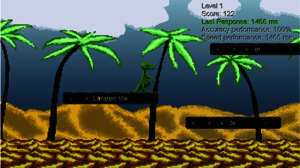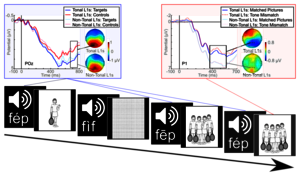Language Acquisition
Learning word accents and morphology

Since word accents are powerful predictors for the endings of words, they can be useful also for second language learners of Swedish to increment their speed and efficacy of word processing. Indeed, after several years of exposure, second language speakers seem to acquire the connection between word accent and suffix through implicit learning (Schremm, Söderström, Horne, & Roll, 2016). However, to accelerate the process, we designed a computer game for learning and automatizing the connection between word accent and suffix in a playful manner (Schremm, Hed, Horne, & Roll, 2017). The player navigates a dinosaur and jumps on platforms to make decisions as to which ending a word should have based on the tone on the word's stem. Beginner learners do not use word accents predictively (Gosselke Berthelsen, Horne, Brännström, Shtyrov, & Roll, 2018). Using a prototype of the game for two weeks, learners developed a pre-activation negativity for word accents (Hed, Schremm, Horne, & Roll, submitted). A version for learning Swedish morphology has also been developed.
Acquiring word-level tone

Word-level tones are a very common feature in the world's languages. Nonetheless, they are very difficult to acquire in a second language. We investigate how learners respond when they first encounter a foreign tone system. We see evidence for a surprisingly rapid acquisition of artificial words with grammatical tone. Accuracy and response times improve and grammatical event-related potentials (ERPs, e.g. P600) emerge within just 20 minutes (Gosselke Berthelsen, Shtyrov, Horne, & Roll, 2020). However, only learners with tone in their native language can pre-attentively classify the non-native tones and rapidly produce early grammar-related ERP components (ELAN / LAN). Similarly, only learners with a tonal native language react when the tone component of a word is incompatible with the meaning of a following picture (Gosselke Berthelsen, Shtyrov, Horne, & Roll, manuscript in preparation).
